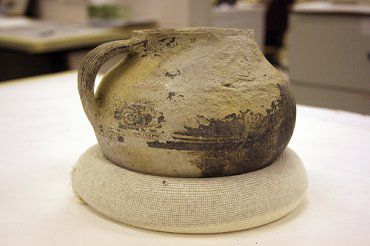A pot discovered under a rock in one of the canyons in the Manti-LaSal National Forest in early December may be between 800-1000 years old.
“We will be doing a lot of study on this, but it appears to be Anasazi or Fremont in origin,” said Charmaine Thompson, the archaeologist for the Manti-La Sal National Forest.
It was found when Casey Mickelsen, DWR conservation officer, was patrolling the area and saw it sitting under an outcropping.
“Someone did us quite a favor a long time ago,” said Renee Barlow, the archaeologist for the College of Eastern Utah Museum, which collaborated with the National Forest Service on collecting the artifact. “They sat it under the rock resting gently on this bed of cedar bark. It is in fantastic shape.”
A team of Forest Service personnel, CEU officials, Mickelsen – who found the artifact – removed it from its near-millenia resting place on Friday afternoon.
“One of the best things that could happen was that Casey found it and did all the right things to take care of it,” said Thompson. “He realized its importance, put rocks around the opening to keep anyone else from finding it and contacted us immediately. We then contacted the CEU Museum to help us remove it because they have the expertise to handle and work with delicate artifacts like this.”
The Fremont and Anasazi often traded items and there is speculation that it could be from either group and may have originated as far away as Arizona. But both archaeologists agreed that the Fremonts also often copied Anasazi pottery and it could be one of the copies as well.
“It would be wonderful if it was locally made,” stated Barlow. “But either way is exciting. It’s a win-win for everyone; for the museum, for the forest service and for the public.”
The pot and accompanying base material will be under study for some time, but both agencies are determined to put it on display for the public as soon as possible.
“We like to keep artifacts in official repositories as close to the sources where they were found as possible,” said Thompson. “It will be displayed here at the CEU museum and we will also be working to display it at the Museum of the San Rafael in Emery County as well, so people there can see it as well.”
“It’s a thrill for the CEU museum to be involved in a project like this,” said Barlow. “Its the best of both worlds; not only will we be able to use all the information with it and around it, but it was found in situ. It is where the ancients left it 800 or 900 years ago.”
The pot has art on it although at this point some of that is covered by residue of various kinds. It is also full of sediment from the years of sitting under the rock. That could mean there is food particles in the bottom as well, which would give researchers more to go on.
“While it was sitting there uncovered, it could have been completely covered at one time and the sediment is left from that,” said Thompson. “But regardless, research wise this is a treasure.”
Work will begin right away with specialist coming into the museum to study the pot. In addition some chemical analysis will be done either at the museum or at a research facility that specializes in this kind of artifact.
View a video about this find by clicking here. More information will also be released about the find next week.
Pot found in Manti-LaSal thought to be several centuries old

"The pot has been well preserved and is in extraordinarly good condition."
